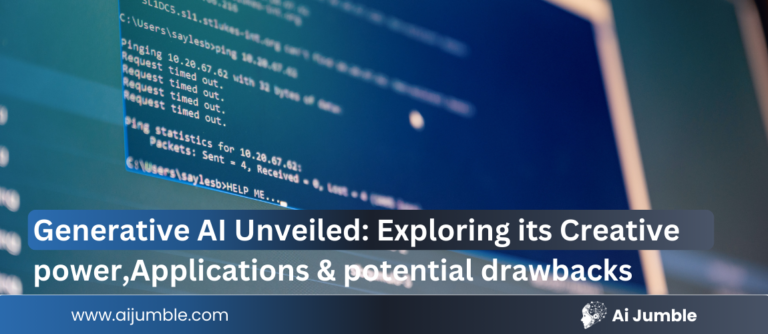Generative AI in Organizations is revolutionizing business processes, yet companies often stumble into the “3C traps”—cost, culture, and cybersecurity risks—resulting in financial hurdles, cultural resistance, and security breaches. If not addressed, these barriers can diminish the return on investment (ROI) and expose businesses to significant vulnerabilities. Let’s explore how to tackle these challenges head-on and unlock the true potential of enterprise AI adoption.
What Is Generative AI and Why It Matters in Organizations?
Generative AI refers to AI systems capable of creating content, be it text, images, or even code, by learning from prior data. Its applications are vast, from customer support automation to product innovations. However, successful generative AI implementation requires a delicate balance of strategy, investment, and adaptability to avoid common pitfalls.
1. The Cost of Generative AI Implementation
Generative AI promises innovation, but the financial commitment often catches businesses off guard. Tackling AI cost management is critical to sustain AI initiatives without jeopardizing broader organizational goals.
Breaking Down Costs:
-
Technology Costs:
- Cloud Computing Resources: Platforms like <aAWS or Microsoft Azure can incur high expenses for hosting large-scale AI models.
- Licensing Fees: Proprietary AI tools like OpenAI’s GPT models require significant licensing investments.
- Data Management: Cleaning, storing, and processing massive datasets demands premium infrastructure.
-
Talent Costs:
- Recruiting Experts: Hiring AI specialists or data engineers comes at a steep price.
- Upskilling Teams: Educating existing staff on AI tools and processes involves substantial training budgets.
-
Operational and Maintenance Costs:
- Model Training and Fine-Tuning: Continuous training and fine-tuning of models to improve accuracy and relevance incur ongoing costs.
- Monitoring and Optimization: Real-time monitoring of AI systems to ensure performance and reliability adds to operational expenses.
Mitigation Strategy:
- Launch small-scale pilot projects to test feasibility.
- Optimize cloud-based AI services to limit costs.
- Identify high-value use cases tightly aligned with business outcomes.
2. Cultural Barriers to Enterprise AI Adoption
Resistance to change is often the greatest roadblock to AI culture change in enterprises. The human factor—fears, misunderstandings, and ethical concerns—can prevent organizations from realizing AI’s potential.
Challenges:
-
Job Security Fears:
Employees may resist or reject AI tools, fearing automation will replace their roles. -
AI Illiteracy:
Teams unfamiliar with AI applications may misuse tools or fail to reap their benefits. -
Ethical Dilemmas:
Concerns around bias, misinformation, and intellectual property can create divisions. -
Over-Reliance on AI:
There’s a risk of employees becoming overly dependent on AI, leading to a loss of critical thinking and creativity.
Mitigation Strategy:
- Lead with transparency, clearly communicating AI’s role in augmenting, not replacing, human work.
- Create an AI literacy program with hands-on workshops and training to educate employees.
- Draft and enforce an AI governance framework to outline ethical AI usage guidelines.
3. Cybersecurity Risks From Generative AI
Generative AI’s reliance on data makes it increasingly susceptible to security threats. Addressing AI cybersecurity risks is essential to protect sensitive information and mitigate potential breaches.
Key Vulnerabilities:
-
Data Breaches:
Sensitive datasets used to train models may attract bad actors. -
Adversarial Attacks:
Cybercriminals can manipulate AI outputs using adversarial data techniques. -
Compliance Risks:
Non-compliance with GDPR or other regulations can lead to legal and financial repercussions. -
Model Vulnerabilities:
AI models themselves can be targeted. For example, attackers can manipulate input data to produce incorrect or harmful outputs (adversarial examples).
Mitigation Strategy:
- Employ stringent data privacy protocols to ensure compliance.
- Use in-house data for training where possible to protect proprietary information.
- Regularly audit and stress-test models for vulnerabilities.
- Partner with cybersecurity firms for AI-specific threat defense.
Generative AI has the power to transform businesses, driving growth, efficiency, and innovation. However, escaping the 3C traps—cost, culture, and cybersecurity—requires strategic foresight and commitment. By managing costs, fostering cultural readiness, and safeguarding AI systems, your organization can harness the full potential of generative AI for a competitive edge in the digital age.
Start small, plan strategically, and ensure AI initiatives create sustainable value for your enterprise. Generative AI isn’t just a trend; it’s the future of enterprise success.
FAQs
Start small by identifying specific, high-impact use cases where generative AI can add measurable value. Conduct pilot projects to assess feasibility and ROI before scaling. Ensure you have the right infrastructure, talent, and data governance practices in place to support AI adoption.
Costs can be managed by leveraging cloud-based AI services for scalability, focusing on essential use cases, and continuously monitoring for ROI. Opt for open-source platforms when possible, and invest in staff training to maximize internal resource utilization.
Transparent communication is key. Explain how AI will augment employees' roles rather than replace them. Provide AI literacy training and involve employees in AI projects to build trust and understanding.
Organizations face risks such as data breaches, adversarial attacks, misuse of generative models (e.g., phishing or deepfakes), and model vulnerabilities. Robust data governance, regular audits, and proactive defense mechanisms are crucial to mitigating these risks.
Establish clear ethical guidelines to address concerns about bias, misuse, and intellectual property. Regularly review AI practices to ensure compliance with regulations and ethical standards.
Stay Updated on the Latest in AI
New AI tools are launching every day — we make sure you’re the first to know. Join a growing community exploring 5,000+ AI tools, with new ones added daily.







